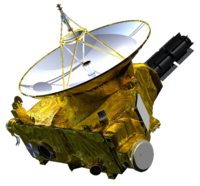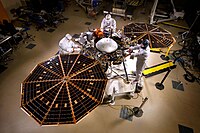-
Use Cases
-
Resources
-
Pricing
History of NASA Timeline
(1958 - Present)Founding and Early Years
Formation of NASA
Oct 1, 1958
% complete
The National Aeronautics and Space Administration (NASA) is established by the United States government, bringing together various space-related programs and initiatives to advance space exploration, scientific research, and technological development.
Image source: NASA

Human Spaceflight
Mercury-Redstone 3 (Freedom 7)
May 5, 1961
% complete
Alan Shepard becomes the first American to travel into space aboard the Mercury spacecraft, Freedom 7. This suborbital flight lasts for 15 minutes and reaches a maximum altitude of 187.5 kilometers (116.5 miles).
Image source: Mercury-Redstone 3

Apollo 11 Moon Landing
Jul 20, 1969
% complete
The Apollo 11 mission, led by astronauts Neil Armstrong, Buzz Aldrin, and Michael Collins, successfully lands the Lunar Module (LM) Eagle on the Moon's surface. Neil Armstrong takes the historic first step onto the lunar surface, stating, "That's one small step for man, one giant leap for mankind."
Image source: Apollo 11

Apollo 13 "Successful Failure"
Apr 11, 1970
% complete
The Apollo 13 mission encounters a critical failure en route to the Moon, forcing the crew to abort their lunar landing. Through ingenuity and teamwork, the crew and mission control successfully navigate and safely return the astronauts to Earth, showcasing NASA's ability to handle emergencies in space.
Image source: Apollo 13

Apollo-Soyuz Test Project
Jul 15, 1975
% complete
The Apollo-Soyuz Test Project (ASTP) marks the first joint space mission between the United States and the Soviet Union. The mission includes the docking of an American Apollo spacecraft with a Soviet Soyuz spacecraft, symbolizing the end of the Space Race and the beginning of international cooperation in space.
Image source: Apollo–Soyuz

Space Shuttle Program Begins
Apr 12, 1981
% complete
The Space Shuttle program commences with the launch of Space Shuttle Columbia (STS-1). The reusable Space Shuttle vehicles play a crucial role in various missions, including satellite deployment, space station assembly, and scientific research.
Image source: Space Shuttle program

Challenger Space Shuttle Disaster
Jan 28, 1986
% complete
Space Shuttle Challenger disintegrates shortly after launch, resulting in the loss of all seven crew members. This tragic event leads to a temporary suspension of the Space Shuttle program and prompts significant safety improvements in subsequent missions.
Image source: Space Shuttle Challenger disaster

International Space Station (ISS) Assembly Begins
Nov 20, 1998
% complete
The first component of the International Space Station (ISS), the Russian module Zarya, is launched into orbit. Over the years, multiple countries contribute modules and conduct scientific research on the ISS, fostering international collaboration in space exploration.
Image source: International Space Station

First All-Female Spacewalk
Oct 18, 2019
% complete
NASA astronauts Christina Koch and Jessica Meir conduct the first all-female spacewalk outside the International Space Station (ISS). This milestone highlights the achievements of women in space exploration and serves as an inspiration for future generations.
Image source: Extravehicular activity

SpaceX Demo-2 Mission
May 30, 2020
% complete
NASA's SpaceX Demo-2 mission marks the first crewed launch from American soil since the retirement of the Space Shuttle program in 2011. Astronauts Robert Behnken and Douglas Hurley launch aboard the SpaceX Crew Dragon spacecraft and dock with the International Space Station.
Image source: Crew Dragon Demo-2

Artemis Program Announcement
Mar 26, 2021
% complete
NASA announces the Artemis program, aiming to return humans to the Moon by 2024 as a stepping stone for future crewed missions to Mars. The program aims for sustainable lunar exploration, including the establishment of the Lunar Gateway space station.
Image source: Artemis program

Robotic Missions
Viking 1 Mars Landing
Jul 20, 1976
% complete
The Viking 1 spacecraft, part of NASA's Viking program, becomes the first successful mission to land a spacecraft on Mars. The lander conducts experiments and captures images of the Martian surface, providing valuable insights into the planet's geology and atmosphere.
Image source: Viking 1

Voyager 2 Flybys of Jupiter, Saturn, Uranus, and Neptune
Aug 20, 1977
% complete
Voyager 2 conducts flybys of Jupiter, Saturn, Uranus, and Neptune, capturing detailed images and data on these gas giant planets and their moons. The Voyager missions provide unprecedented insights into the outer solar system and continue to transmit valuable data.
Image source: Voyager 2

Pioneer 10 Becomes First Spacecraft to Leave the Solar System
Jun 13, 1983
% complete
Pioneer 10, launched in 1972, becomes the first spacecraft to exit the heliosphere and venture into interstellar space. It continues to transmit data until January 2003, providing insights into the outer regions of the solar system.
Image source: Pioneer 10

Mars Pathfinder Mission
Dec 4, 1996
% complete
The Mars Pathfinder spacecraft successfully lands on Mars, deploying the Sojourner rover. This mission provides valuable data on the Martian surface, including detailed images and geological analysis, paving the way for future Mars exploration.
Image source: Mars Pathfinder

Mars Exploration Rovers (Spirit and Opportunity)
Jan 3, 2004
% complete
NASA's Mars Exploration Rovers, Spirit and Opportunity, successfully land on Mars. These rovers explore the Martian surface, studying rocks, soil, and the planet's geology, providing evidence of past water activity and expanding our understanding of Mars' potential habitability.
Image source: Mars Exploration Rover

Mars Reconnaissance Orbiter Arrival
Mar 10, 2006
% complete
The Mars Reconnaissance Orbiter (MRO) reaches Mars and begins its mission to study the planet's atmosphere, surface, and subsurface. MRO's high-resolution imaging capabilities provide detailed maps and images of Mars, aiding future landing site selection and exploration.
Image source: Mars Reconnaissance Orbiter

Dawn Mission to Asteroids Vesta and Ceres
Sep 27, 2007
% complete
The Dawn spacecraft embarks on a mission to study the two largest objects in the asteroid belt, Vesta and Ceres. Dawn provides detailed images and data on these protoplanets, enhancing our understanding of the early solar system and planetary formation.
Image source: Dawn (spacecraft)

Kepler Mission Discovers Thousands of Exoplanets
Mar 6, 2009
% complete
The Kepler space telescope, launched by NASA, discovers thousands of exoplanets orbiting distant stars. This mission revolutionizes our understanding of planetary systems and the prevalence of exoplanets in the Milky Way galaxy.
Image source: Kepler space telescope

Lunar Reconnaissance Orbiter Launch
Jun 18, 2009
% complete
The Lunar Reconnaissance Orbiter (LRO) is launched to study the Moon's surface, resources, and environment. LRO's instruments provide high-resolution images and data, aiding future lunar exploration and potential human missions.
Image source: Lunar Reconnaissance Orbiter

Juno Mission to Jupiter
Aug 5, 2011
% complete
The Juno spacecraft enters orbit around Jupiter, becoming the first solar-powered spacecraft to reach the gas giant. Juno's mission is to study Jupiter's atmosphere, magnetic field, and gravitational field, shedding light on the planet's formation and evolution.
Image source: Juno (spacecraft)

Mars Science Laboratory (Curiosity Rover)
Aug 6, 2012
% complete
The Mars Science Laboratory mission successfully lands the Curiosity rover on Mars. This car-sized rover explores Gale Crater, providing valuable data on Mars' past habitability and geological history.
Image source: Curiosity (rover)

Voyager 1 Enters Interstellar Space
Aug 25, 2012
% complete
Voyager 1 becomes the first human-made object to enter interstellar space. Launched in 1977, this spacecraft continues to provide valuable data about the outer regions of the solar system and the interstellar medium.
New Horizons Pluto Flyby
Jul 14, 2015
% complete
The New Horizons spacecraft conducts a close flyby of Pluto, capturing detailed images and collecting data on Pluto's atmosphere, surface, and moons. This mission provides the first up-close exploration of the distant dwarf planet.
Image source: New Horizons

Mars InSight Lander Arrival
Nov 26, 2018
% complete
NASA's InSight lander successfully touches down on Mars, aiming to study the planet's deep interior and seismic activity. InSight's instruments provide valuable data to understand Mars' geological processes and its similarities to Earth.
Image source: InSight

Perseverance Rover Mars Landing
Feb 18, 2021
% complete
NASA's Perseverance rover successfully lands in Mars' Jezero Crater. The rover's mission includes searching for signs of ancient microbial life, collecting samples for future return to Earth, and demonstrating technologies for future Mars missions.
Image source: Perseverance (rover)

Mars Perseverance Rover's Ingenuity Helicopter Flight
Apr 19, 2021
% complete
NASA's Mars Perseverance rover deploys the Ingenuity helicopter, which successfully performs the first powered flight on another planet. This achievement demonstrates the feasibility of aerial exploration in the Martian environment.
Image source: Ingenuity (helicopter)

Mars Sample Return Mission Announcement
Apr 28, 2021
% complete
NASA announces plans for a Mars Sample Return mission in collaboration with ESA. This ambitious mission aims to collect samples from Mars and return them to Earth, allowing scientists to analyze them more comprehensively.
Image source: Mars sample-return mission

Technological Advancements
Hubble Space Telescope Launch
Apr 24, 1990
% complete
The Hubble Space Telescope, a collaboration between NASA and the European Space Agency (ESA), is launched into orbit. This powerful telescope revolutionizes astronomy by capturing stunning images of distant galaxies, nebulae, and other celestial objects.
Image source: Hubble Space Telescope

Key Facts
- NASA was established on July 29, 1958, as a response to the Soviet Union's launch of Sputnik 1.
- The Mercury program, launched in 1959, made NASA the first space agency to send humans into space.
- The Apollo program, which began in 1961, successfully landed humans on the Moon for the first time in 1969.
- The launch of the Hubble Space Telescope in 1990 revolutionized our understanding of the universe.
- NASA's Mars rover missions, starting with Sojourner in 1997 and continuing with Curiosity and Perseverance, have provided valuable data about the Red Planet.
Source
This History of NASA timeline was generated with the help of AI using information found on the internet.
We strive to make these timelines as accurate as possible, but occasionally inaccurates slip in. If you notice anything amiss, let us know at [email protected] and we'll correct it for future visitors.
Create a timeline like this one for free
Preceden lets you create stunning timelines using AI or manually.
Customize your timeline with one of our low-cost paid plans
Export your timeline, add your own events, edit or remove AI-generated events, and much more
Free
$
0
free forever
No credit card required.
Basic
$
10
/month
billed annually
Cancel anytime.
Pro
$
16
/month
billed annually
Cancel anytime.
Common Questions
Can I cancel anytime?
Yes. You can cancel your subscription from your account page at anytime which will ensure you are not charged again. If you cancel you can still access your subscription for the full time period you paid for.
Will you send an annual renewal reminder?
Yes, we will email you a reminder prior to the annual renewal and will also email you a receipt.
Do you offer refunds?
Yes. You can email us within 15 days of any payment and we will issue you a full refund.
What if I have more questions?
Check out our pricing docs or send us an email anytime: [email protected].